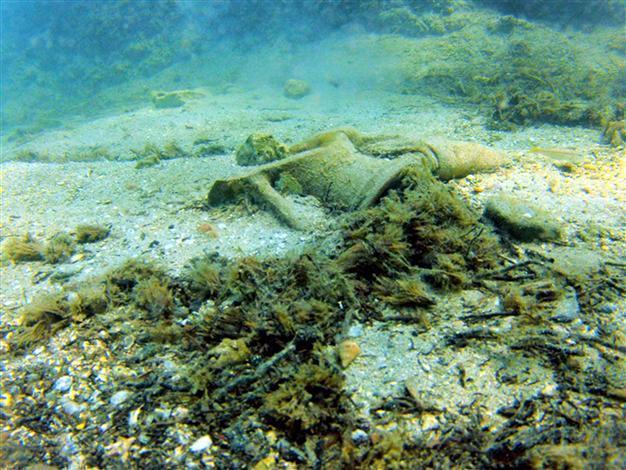Sunken Ottoman ship ready to surrender cargo for exhibition
İZMİR - Anadolu Agency

Of the many ship remains found, a vessel from the seventh-century B.C. and an 18th-century Ottoman warship were taken into complete preservation underwater. AA photo
Work has begun to unearth and exhibit ship remains from different eras that were discovered during an underwater excavation in the 6,000-year-old town of Limantepe on Turkey’s western coast.A sunken 17th-century Ottoman merchant ship that was transporting plates from the Netherlands will be brought out of the water and exhibited.
It has been 13 years since the underwater excavations started in Limantepe, a site that attracted the interest of researchers when they could not initially identify areas in the sea on aerial photographs of the İskele neighborhood in the district of Urla.
Twenty underwater archaeologists, under the direction of Professor Hayat Erkanal, are taking part in the excavations in Limantepe, the site of a prehistoric settlement which witnessed humanity’s passage from being hunter-gatherers to farmers. Limantepe was also a settlement during the Roman period, but an earthquake or other cataclysmic event that took place in the sixth-century B.C. submerged the port.
The excavations, coordinated by the Ankara University Underwater Research and Application Center (ANKÜSAM), are continuing on the base of the port that dates back to the seventh-century B.C. Erkanal has reported that they discovered many ship remains from different eras and items that came out of these ships, which have been desalinated in a laboratory in preparation for exhibition.
Limantepe, known as Klazomenai during the Classical age, encompasses a vast region underwater, meaning excavations are likely to continue in the upcoming years, said Erkanal.
Of the many ship remains found, a vessel from the seventh-century B.C. and an 18th-century Ottoman warship were taken into complete preservation underwater, according to Erkanal. Another ship was also discovered by fishermen 400 meters from the excavation site at a depth of 17 meters.
Exhibition only after desalination
After the analysis of the new discovery, the ship was determined to be a 17th-century Ottoman merchant ship.
Noting that the ship had sunken along with plates that it was transporting from the Netherlands: Erkanal said: “We estimate that there are more than a thousand plates inside this ship. The ship remains may degenerate because it was not fully embedded beneath the sea floor. Also there are threats from fishing nets and ill-intentioned people. We have to immediately unearth these remains that are beyond the boundaries of our excavation area.”
He also said the unearthed items had to be desalinated before they could be exhibited, otherwise items – even stone – could break to pieces.
Erkanal said their current equipment and systems were insufficient to remove items from underwater, while noting that a new center that will open next year will have an advanced laboratory.
“Since the construction of the new center and the new laboratory has already started, we initiated the project to remove the ship from under the water. Next year we will dive and first remove the Dutch plates, which we believe to be really valuable. Later, we will unearth the parts of the ship that made it to the present and begin restoration and conservation processes on them. After all the work is done, we are planning to reload the plates onto the ship and exhibit them together, the way they were originally,” he said.
Third in Turkish history
The bid to excavate the ship will be the third such undertaking in Turkish history, Erkanal said, noting the previous Uluburun excavation in the southwestern district of Kaş by the U.S.-based Institute of Nautical Archaeology and the recent removal of Byzantine-era ships from Yenikapı as part of the work for the Marmaray.
Erkanal said they would make a proposal to the Culture and Tourism Ministry to exhibit the shipwreck at an archaeological park in the vicinity of the excavation site in Urla. If their proposal is accepted, the ship will be put on display in a specially monitored room, he added.
Noting that they would also work on unearthing other ships in the area in the future, Erkanal said the exhibitions of shipwrecks would be vital in making İzmir a world-renowned center for underwater archaeology.
In addition to underwater excavations, ANKÜSAM collaborates with the 360 Degree History Research Group in reconstructing and exhibiting historical vessels and ships, according to Erkanal.
“The ships that we exhibit around our excavation site have attracted great attention from the public. We are planning to unearth the entire pier of Limantepe located underwater offshore.”

















